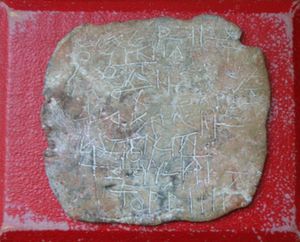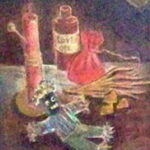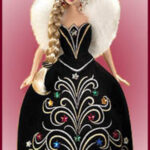General information about Curse Tablets has been gathered from Magic, Witchcraft, and Ghosts in the Greek and Roman Worlds by Daniel Ogden, specifically his chapter “Curses.” This essay focuses on the curse tablets of Ancient Greece in the Classical and Hellenistic period.
Buried across what was Ancient Greece are curse tablets, or binding spells (in Greek katadesmoi, Latin defixiones), which were messages to the dead, gods, or mythological creatures asking for the author’s enemies or love interests to be bound. Folded, paired with a voodoo doll, sometimes nailed, and strategically placed, the curses physically represented the words within them. The cold, heavy, twisted position of the lead tablet was representative of a deeper symbolism of the intended suffering the victim was desired to face. Currently there are about 1,600 curse tablets that have been found, mostly inscribed in Greek, dating back from 500 B.C.E. and on. Their existence provides much insight into the ancient world’s culture.
Materials
It seems as though lead was the desired medium in which Greeks chose to write their curses simply because there are few remains of anything else being used. This is not true, though. Evidence of magical recipes for spells request that the spell-caster “take some hieratic paper or a sheet of lead” (qtd. in Graf 133). Literary sources reveal that the three most common materials to write binding spells on were wax tablets, papyrus (also known as hieratic paper), and lead. Other materials included ostraka (broken pieces of pottery), limestone, gemstones, and ceramic bowls (Gager 3) Another source reports findings of bronze, copper, and talc (Ankarloo and Clark 10). Some recipes, like the one mentioned above, require gold or silver but are only represented in protective amulets.
The most probable reason for heavy use of lead is due to its availability and ease of inscription. Greeks had discovered silver mines near Athens. Since lead is a byproduct of refining silver, there was much to go around. By the end of the fifth century, the Greeks had mined all the silver but also had obtained large amounts of lead. The number of lead findings begins to diminish shortly after the fifth century simply because the refining has ceased (Faraone).
Lead was already used for various written purposes such as documents and private letters. This has led some scholars to believe that Greeks wrote the curses as letters to the dead or other powers that could assist them in their endeavors. Another view, coexisting with the previous, is that the lead was a symbolism of the actions the author wanted performed on the proposed victims. One author requested “that their victims become as cold and useless as the lead upon which the curse is written” (Ankarloo and Clark 12).
Voodoo Dolls and Twisted Symbolism
Sometimes the curses are found with a small figurine referred to as a voodoo doll (or kolossoi in Greek). The dolls often had their hands or legs bound or twisted to symbolize the “binding” of the cursed. Similar dolls have been found dating back to much earlier ages, before the earliest known curse tablet. Made of primarily bronze and lead, the dolls are also believed to have been made from wax. One lead tablet from the fourth-century BCE Attica mentions both lead and wax, giving reason to believe that a wax doll may have been placed with the tablet (DTA 54). In the “Idylls of Theocritus,” Simaetha, a Coan girl, casts a spell on her love-interest: “As this puppet melts for me before Hecate, so melt with love, e’en so speedily, Delphis of Myndus.” The association with magic, a figurine, and potentially wax, sheds more light on the possibility of wax figurines being placed with lead curse tablets.
Twisting or binding symbolism is also implemented through the rolling of the tablet and the abnormal lettering. It is not uncommon to see words printed in reverse order or jumbled up to create a better sense of twisting or binding and to also symbolize the confusion of the victim in a debate, for example (Ankarloo and Clark 73). Another feature that has been found is a nail through the metal curse. Made of iron or bronze, the nail enforced greater pain on the accursed or, as in love spells, bound them to the words within the tablet (“Defixiones”). These physical representations become nearly artistic. As an author or orator would use imagery and rhetoric, so the sorcerer uses voodoo dolls, spelling, and nails.
Location
Several sources stress that placement is an important factor when looking at curse tablets. The places the tablets appear are in underground bodies of water (e.g. wells and springs), chthonic sanctuaries (such as one dedicated to Demeter), or places close to the victim (Faraone; Ankarloo and Clark 28). Graves were also a favorable place for the tablets to be placed because the pollution (or miasma) would help to intensify the message and the pollution of the victim themselves. It was believed that if found, the tablets would be deactivated (Ankarloo and Clark 77). This may have been one reason for the choices of placement; these areas would decrease the chance of the tablets being tampered with. Another was to keep the curse close to the accursed. Even if the curse was deposited in a well, the closest well to the “target” was chosen.
Categorization of Curse Tablets
There were five types of curses: litigation (or political) curses, competitive curses, curses of trade, erotic (love/attraction) curses, and prayers for justice. Litigation curses represent nearly ten percent of the recovered tablets. They were written before trials in an effort to confuse the orators or making it so the orator could not appear in court and sway the results in the curser’s favor. The task of cursing was not a destructive or hateful action in these cases, but simply a way of obtaining justice. Earlier tablets mostly state the bind which they want done and lack an address to underworld powers. For example, a Greek tablet dated to late sixth or early fifth century BCE states the binding of “the tongue of Eucles and the tongue of Aristophanis…the tongues of the advocates of Eucles and Aristophanis” (Ogden 211). This is one of the earliest tablets that still survive. It focuses on the part of the body most threatening to the author and lacks a harmful or destructive clause.
In the Classical and Hellenistic periods, competitive curses are not as common as other types of curses. These curses bind athletes, musicians, poets, and people who support or assist with those who the curse-maker is competing against. An early example of this type of curse can be found in Pindar’s Olympian ode: “Poseidon…bind the bronze spear of Oenomaus!” Written in 476 BCE, this curse calls on the assistance of a specific power, Poseidon, to bind Pelops’ competitor, Oenomaus, so he can overpower him. Another author from Attica in late fourth, early third century BCE cursed Theagenes: “All the choral trainers and the under-trainers with Theagenes, both the trainers and the under-trainers” (DTA 34). Again the focus is the threatening parts of the enemies, in this case the spear, the trainers, and the under-trainers.
As Hesiod writes in Works and Days, “for a man grows eager to work when he considers his neighbor, a rich man…; and neighbor vies with his neighbor as he hurries after wealth.” This literary explanation of drive-by-jealousy creates a sense for why curses of trade were created. A curse from fourth century BCE requests that several shopkeepers (or innkeepers) in different trades, and their slaves, have their souls, hands, tongues, feet, and minds bound by Hermes the Restrainer (DTA 87a). This was most likely written by someone in a similar trade, but it is speculated that it could have also been a disgruntled customer who wished for these establishments to fail. The curse not only addresses a god for acknowledgement of the declaration but also the direct action to be done (“I bind”, katadesmeuo in Greek) (Ogden 215).
A tradition that doesn’t begin until the fourth century BCE is the erotic curse tablet. Within this category are two subcategories: separation and attraction curses. Written by a woman named Phila, a separation curse tablet was found in the tomb of Macron ideally where it was deposited. It curses against the marriage of Thetima and Dionysophon. Phila states: “may he take no woman other than me, and let me grow old beside Dionysophon, and no other woman.” After Phila commands that the only way to deactivate the curse is for her to dig up and read it, she then requests one last thing. “dear demons…guard this text for me, so that these things don’t come to pass and so that the evil Thetima is destroyed in a fittingly evil fashion. May I become fortunate and blessed” (Ogden 227). This fourth century BCE curse is unusual in the sense that it is an early example of curses that desire someone’s death.
While separation curses were more common in Classical and Hellenistic periods, attraction curses weren’t. A curse to Sime and Aenis written by Pausanias in the late fourth or early third century BCE, denies Sime and Aenis the ability to enjoy sex. A fragment is also written on the reverse side of the tablet stating, “of Melissa of Apollonia.” This could be a reference to a third woman, a maternal lineage of Pausanias, or even the name of the witch who wrote the curse for Pausanias. Either way, this tablet is extremely interesting because it invokes a very specific kind of binding, references gods in a way that does not ask for their assistance in the curse, and gives only the curse-maker the right to undo the spell.
The last of the curse categories are the prayers for justice. These curses most commonly seek revenge for things that have been stolen from the author. A curse written by Artemisie, a mother who has lost her daughter, states that the child’s father will not be able to give his parents a burial nor will his children have a tomb for him since he did not provide that for Artemisie’s daughter. She calls on Oserapis and the gods sitting alongside him for justice. The end of the tablet, the parts that are legible at least, curse anyone who removes the text. The papyri curse was written in the fourth century BCE and placed in the main temple of Oserapis in the Serapeum at Memphis (Ogden 221). Although the curse was placed in Egypt, it is written in Greek and shows an expansion of the curse tablet. The curse also proves of interest because it is written on papyrus which is better able to be preserved in the Egyptian desert than in Greece (Faraone).
Conclusion
The Ancient world of Greece has many spectacles: the Parthenon, the Temple of Artemis at Ephesus, the many mythological stories, and the general actions of Ancient Greeks. These are simply examples of the many features of Grecian history that entice historians, archaeologists, and literarians. Curse tablets are another intriguing addition. More than vases, sculptures, architecture, or literary works, curse tablets do not have boundaries of gender, literacy, or class. This distinction from other preserved works and findings can help to give a more rounded view of the ancient society, even if it is a small piece of a greater puzzle.
Curses for love, for destruction, for restitution, or for jealousy all have a similarity in their symbolism. Either through piercing with nails, pairing with voodoo dolls, jumbling word order, or folding of the tablets, the curses each feature a form of twisting or binding in a physical sense just as they are expected to bind the victim in a magical sense.
Works Cited
Ankarloo, Bengt, and Stuart Clark. Ancient Greece and Rome. Philadelphia: University of Pennsylvania, 1999. Print.
Classical E-Text: THEOCRITUS, IDYLLS 1 – 4.” THEOI GREEK MYTHOLOGY. Web. 6 Mar. 2010. .
“Defixiones: Curse Tablets – Archaeology Expert (UK).” Extensive Information on Archaeology and Artefacts at Archaeology Expert (UK). Web. 5 Mar. 2010. .
Faraone, Christopher A. “Ancient Greek Curse Tablets.” The Fathom Archive. 2001. Web. 5 Mar. 2010. .
Gager, John G. Curse Tablets and Binding Spells from the Ancient World. New York: Oxford UP, 1992. Print.
Graf, Fritz. Magic in the Ancient World. Cambridge, Mass.: Harvard UP, 1997. Print.
Hesiod, and T. A. Sinclair. Hesiod, Works and Days,. London: Macmillan, 1932. Print.
Ogden, Daniel. Magic, Witchcraft, and Ghosts in the Greek and Roman Worlds: a Sourcebook. Oxford: Oxford UP, 2002. Print.
“Pindar, Olympian, Olympian 1 For Hieron of Syracuse Single Horse Race 476 B. C.” Perseus Digital Library. Web. 6 Mar. 2010. .





